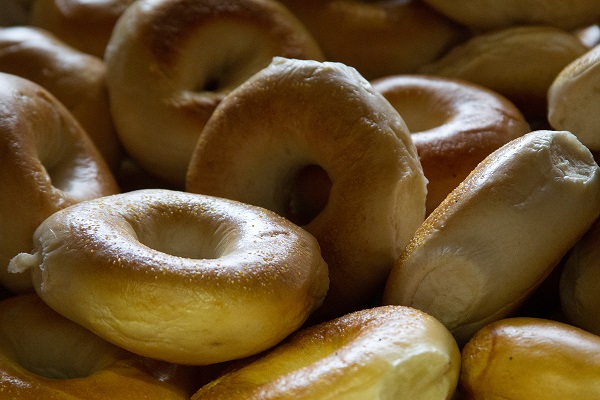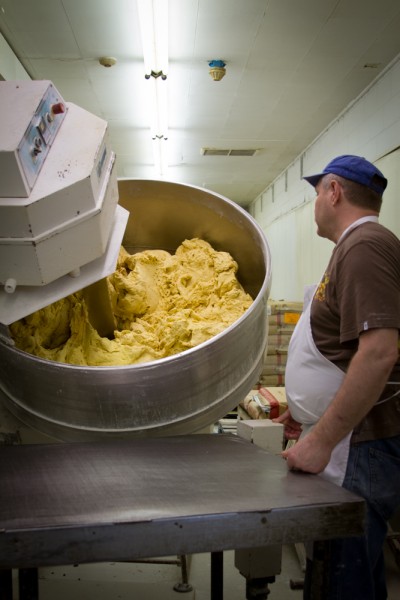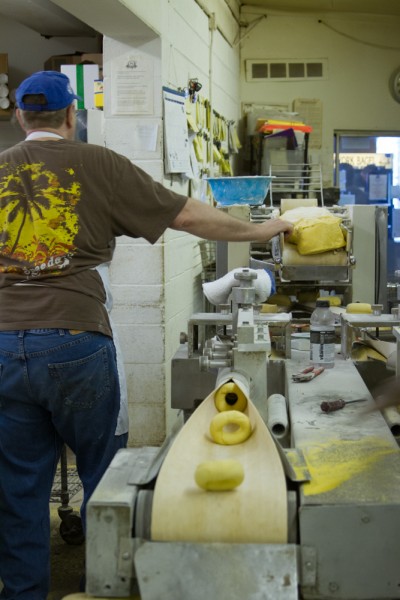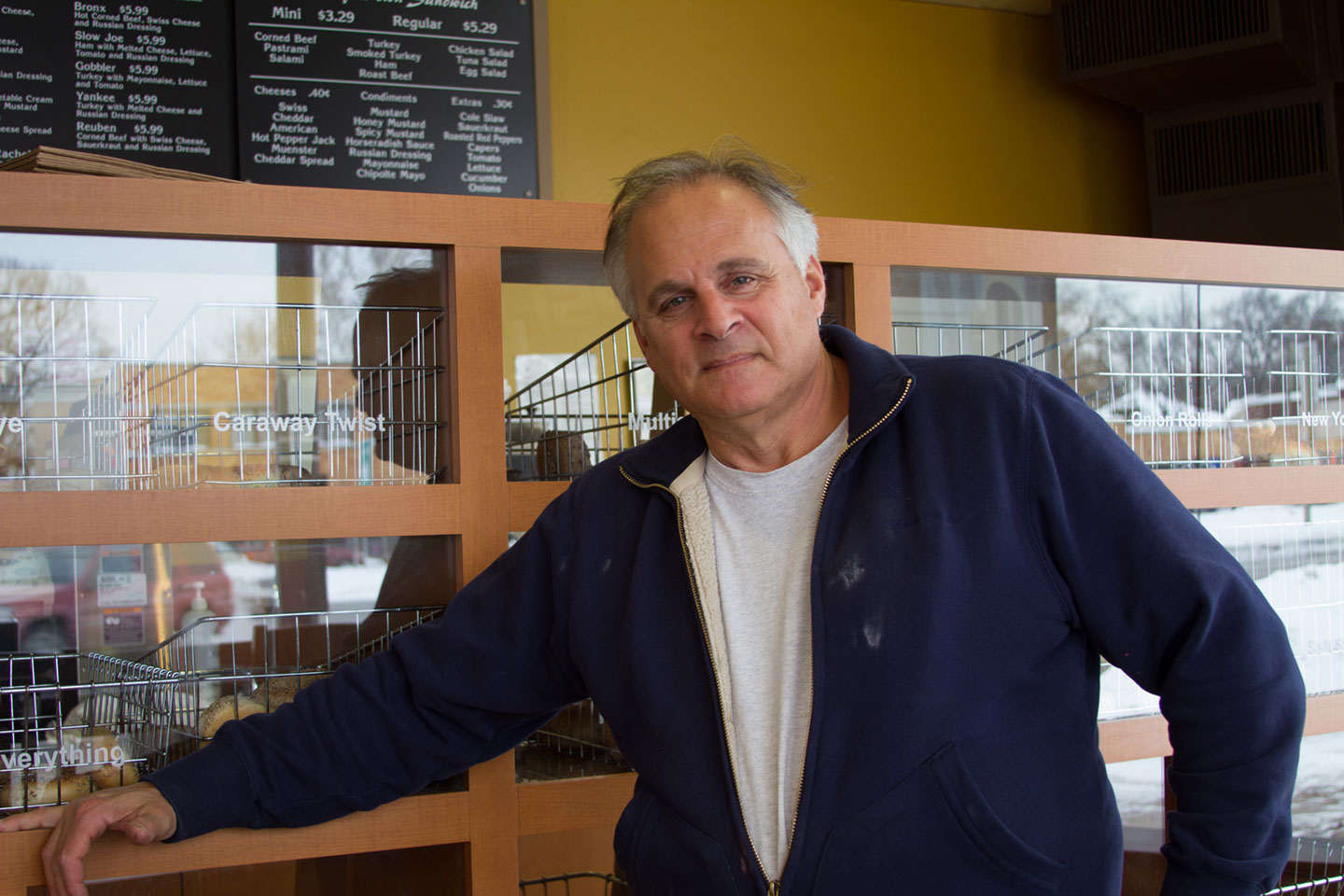Ever wonder where bagels come from?
Pondering the mystery — and history — of the Detroit New York Bagel, it’s lunchtime when we drop in to chat with Howard Goldsmith, owner and proprietor of New York Bagel Baking Co.
For Detroiters, the shop on Woodward in Ferndale is an institution, serving hands-down “The Best Bagels” according to those who know the distinction between a bagel and a roll with a hole.

“Born and bread in Detroit,” New York Bagel is a third-generation family business, a rarity in this day and age of fast and frozen food. “My grandfather, Morris, started the business in 1921 with two Eastern European immigrants who took over another bagel shop downtown,” explains Howard. “They renamed the store ‘New York Bagel’ since bagels were introduced into the U.S. in New York City.” Morris eventually became sole proprietor and shortly after, Howard’s father, Harvey, joined him.
As Jewish Detroit moved over the years, New York Bagel followed. Howard recollects that there was a store location at Linwood and Clairmount Street, but his first vivid memories stem from the shop on Schaeffer and Seven Mile which opened in 1954. “We just sold bagels there,” he describes. “Right next door, there was a grocery store – House of Foods – and people went there for their lox and cream cheese.”
In the 1960’s, when bagel production became automated, New York Bagel opened its first suburban Detroit store in Oak Park, followed by the Ferndale location, then the store on Orchard Lake in West Bloomfield.
Born to bagels?
A speech and language therapist by training, working as an assistant professor at the University of Wisconsin in Milwaukee, in 1987 Howard returned to Detroit with his wife, Carole, and young family to take on the business in partnership with his dad. “My father had always left the door open for me; we had a third child on the way and I was thinking about our future. I looked for other academic positions and it all seemed the same, and I decided then to make a career of this. My dad and I initially shared responsibility, now he’s retired. So this is my baby.”
Asked about the chance of a fourth generation stepping into the business, Howard is philosophical. “I wouldn’t rule anything out, but I would be surprised.” With daughter, Andree (29) working as an attorney in Washington D.C. and son, Michael (26) an actor in New York City, Philip (32) is the one NEXTGener in the Goldsmith family who lives in town. “I believe Phil will take a different path in business,” says Howard. “And look, nothing lasts forever.” Fortunately for Detroit bagel lovers, New York Bagel is still going strong.
So what makes a bagel a New York Bagel?
Flour. Water. Yeast. Malt. And tradition. You probably don’t think much about it when you stop in for your fresh dozen of plain, salted, poppy and sesame. But, those New York Bagels that we all know and love come piping hot out of the oven like clockwork on production days — 170 dozen to a batch, 25,000 dozen a week.
You don’t think twice about the perfect consistency of a New York Bagel – not to mention the time honored-Jewish culinary ritual of setting out a tray of bagels, schmear and lox on a Sunday morning, but someone has to keep the tradition alive in Detroit and that someone is Howard.

“You have to know what you’re doing,” says Howard. “There’s the Einstein thing where bagels come in to the store frozen. Here we make everything from scratch. For us, there’s more of an art and a science to it. First of all, there’s the recipe.”
Not to be attempted at home, the recipe for New York Bagels starts in the Baking Company with 350 pounds of flour and 160 pounds of water. Batches are made in what looks like a cement mixer; dough is fed in strips through a conveyor to produce uniform rounds. Bagels are then “proofed” – left to rise – then boiled in an alkalized water bath before baking.
“Our bagels have no preservatives at all, so the shelf life isn’t that long,” explains Howard. “There are so many chemicals out there that you could add to the dough, but we don’t put that stuff in, so we have to turn over our product.” Apparently that’s not a problem. With the three stores and a sizeable wholesale distribution, New York Bagel Co. sells and delivers to cafes and markets citywide what most consider to be Detroit’s quintessential bagels. Noting the full menu of New York Bagel provisions from the Bake Shop, Howard adds, “We do ‘flagels’ (flat bagels) and bialys on the weekends. On a average, we whip up about 700 pounds of cream cheese spread every week; we buy our lox from Seafare (another Detroit family business) and Acme from New York; we do the whole thing.”

So what makes a bagel Jewish?
That, my friends, is anyone’s guess. Apparently, the basic roll-with-a-hole concept is centuries old. Non-Jewish, boiled-and-baked, ring-shaped breads are found in Italy, Greece, Finland and Poland, even countries in Asia and Africa. Putting the requisite “schmear” and lox aside, why the European version has prevailed as the bagel of our heritage has as much to do with Jewish identity as anything else.
“My brother from Seattle kills for a caraway salt stick,” says Susie Feldman, Senior Endowment Development Manager at Federation. If I don’t have a one to hand him when he comes to visit, I hear about it.”
Talk about longing for the perfect crunch and chew of a Jewish bagel fresh from the oven, New York Bagel has a large and faithful clientele of former Detroiters who buy bagels to take back home wherever they come in to visit. “I don’t know if they can’t get a bagel like mine anywhere — or if they just want a taste of home, but I’m sure part of it is nostalgia.”
“We used to be able to get bagels late on Saturday night,” Susie recalls. “After a movie, we’d go the deli, then stop at the bagel shop to get fresh bagels for the morning.”
“We used to be open all night on Saturday through Sunday morning. From 11 p.m. to 3 a.m., we were slammed with customers. People just aren’t out like that any more.”
An endangered food?
As ubiquitous as the bagel is thought to be, the real-deal bagel bakery is vanishing, even in New York City. “Talk about losing their way in terms of making a bagel, the bagels I find now in New York are more like gigantic pieces of bread designed for a sandwich,” says Howard.
A “real” bagel is four ounces, about three inches in diameter. Calorie count? About 300 calories (before toppings). Even as bagels have fallen out of favor as a staple for the health conscious, New York Bagel has a whole wheat and multigrain variety. “To literally cut calories, some customers ask us to scoop out the inside, or they take them home and do that themselves,” says Howard. “People find the crust just as good.”
As for a life in bagels? Howard concludes, “Detroit has been good to us. We believe in giving back what we can. After all, we’re all family here.”
***
“A fresh, warm New York Bagel salt stick, schmeared with chive cream cheese is the taste of Sunday brunches, friends in from out of town, holiday dinners, early morning Federation meetings and, most of all, family.” — Robb Lippitt
“My father has been bringing home bagels from New York Bagel every Sunday, our whole lives. It’s a family tradition. Bagels, cream cheese, lox, smoked fish — all the fixings. It’s the perfect way to cap off a weekend. — Andrew Landau




